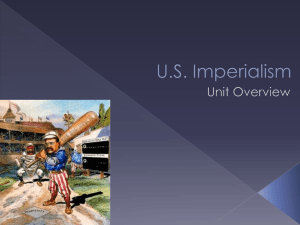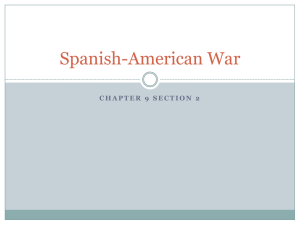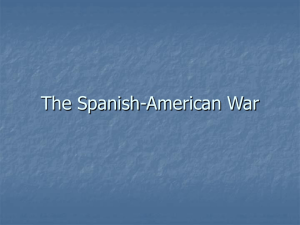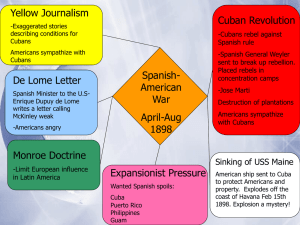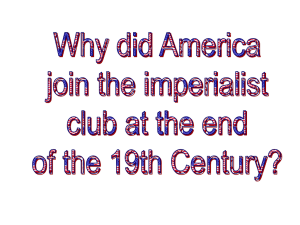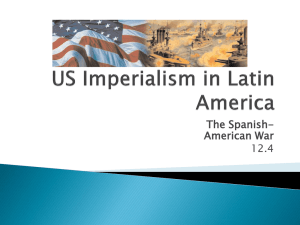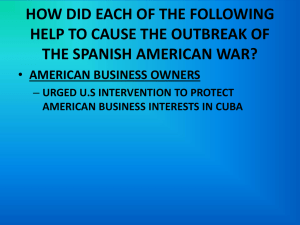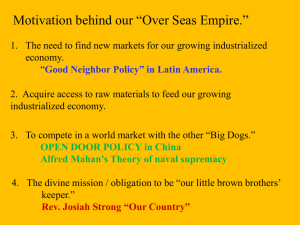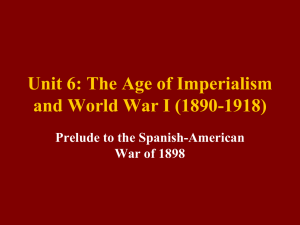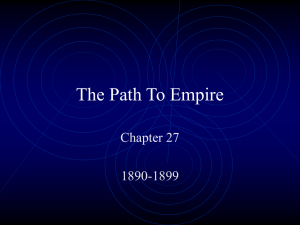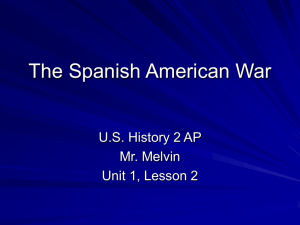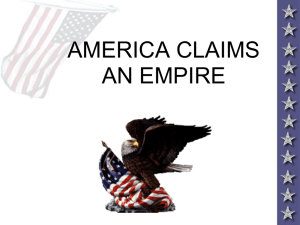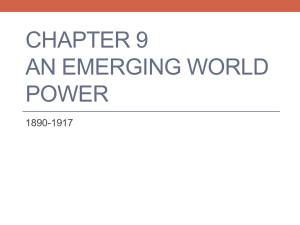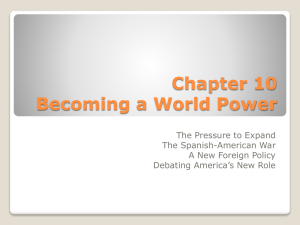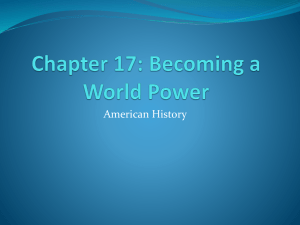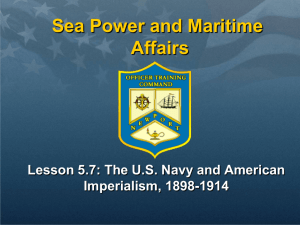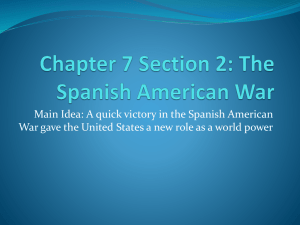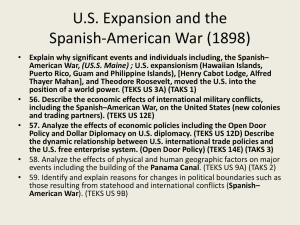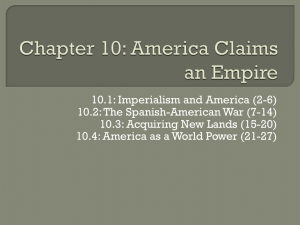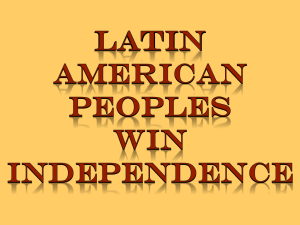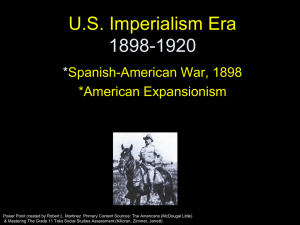Spanish American War Power Point
advertisement
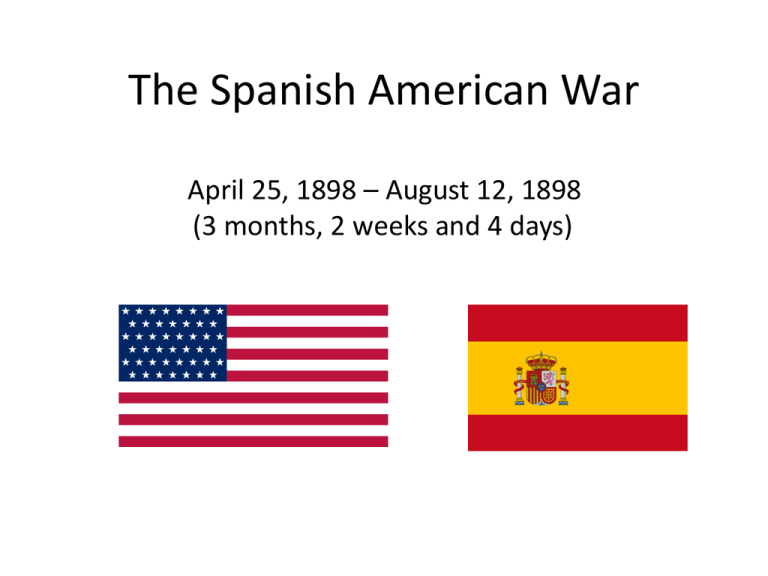
The Spanish American War April 25, 1898 – August 12, 1898 (3 months, 2 weeks and 4 days) In 1823, the United States issued the Monroe Doctrine The United States would no longer tolerate colonization of North or South America. Any such colonization would be treated as an act of aggression against the U.S. The doctrine also stated that the U.S. would not interfere with existing colonies or the internal affairs of European nations. Cuba Libre The Cuba Libre movement was the group within Cuba that wanted independence from Spain. Prior to U.S. military involvement, Cuba Libre opened offices in Florida and New York in order to smuggle weapons and to gain U.S. support for their cause. Protestants and Rural Democrats supported the movement, but U.S. businesses felt it best to ignore the cause. Overall, there was not much early interest in the U.S. for empire building, but other nations had expanded their over seas powers (Britain, France, Germany and Japan). The Ten Years War 1868-1878 American opinion began to change during and just after Cuba Libre made its first major move for independence. The Spanish authorities sent General Valeriano Weyler to quell the rebellion by cutting off military supplies to the rebels. Weyler also forced Cubans to concentration areas close to Spanish military compounds. President McKinley (1897-1901 25th president of the United States (1897-1901) 39th Governor of Ohio (1892-1896) McKinley volunteered for the 23rd Ohio infantry during the Civil War, he was trained as a lawyer, and was a Republican. U.S. President McKinley (1897-1901) saw Weyler’s efforts as barbaric and publically denounced the Spanish efforts as “extermination”. However, it is also true that McKinley, a Civil War veteran, wished to avoid conflict with Spain. His statements may have been made to satisfy an outraged American public. Spain responded to American criticism… Prime Minister Canovas del Castillo claimed that Cuba was not a colony, but a province of Spain. Del Castillo was assassinated in 1878 leaving Spain in political turmoil. Cuba’s future became even less certain. Weyler’s brutal methods, del Castillo’s assassination, and McKinley’s statements led to a greater interest in the Cuban cause. Yellow Journalism American newspaper publishers such as Joseph Pulitzer of the New York World and William Randolph Hearst of the New York Journal took advantage of the situation to sell newspapers. These publishers exploited American outrage and made the Spanish look monstrous. This type of journalism that exploits emotion to sell papers came to be known as “Yellow Journalism” A cartoon from Puck (a humor magazine) in 1888 So Close to Peace… President McKinley wanted to end the fighting in Cuba peacefully and quickly. He sent Stewart Woodford to Spain to negotiate an end to the conflict. Woodford met with Praxedes Sagasta (who had replaced del Castillo) and negotiated Cuban autonomy. Autonomy was scheduled to begin on January 1, 1898. Within days of Cuban autonomy, the U.S. sent the USS Maine in response to unrest. Spanish officers were causing trouble in response to newspaper criticism of Weyler’s policies. On February 15th, 1898, the Maine sank after a mysterious explosion in Havana Harbor. 266 sailors were killed. Although the cause of the explosion was never made clear, McKinley was forced by public opinion to act. Publishers Pulitzer and Hearst stated in their papers that the Maine was sank by the Spanish, but no solid proof has ever been presented. The U.S. Goes to War April of 1898, McKinley was forced to ask Congress for the ability to send troops into a conflict against Spain. Theodore Roosevelt Theodore Roosevelt was Assistant Secretary of the Navy 1897-1898. He was a supporter of war with Spain even though the president wanted to avoid conflict. Ten days after the Maine was sunk, Roosevelt called the Navy to prepare for war, arranged for munitions and supplies, and asked Congress for the power to recruit as many sailors as he wanted • • • • 26th President of the U.S. (1901-1909 25th Vice President of the U.S. (1901) 33rd Governor of New York (1899-1900) Assistant Secretary to the Navy (1897-1898) • Progressive Republican • Resigned from the Navy to lead the Fir U.S. Volunteer Cavalry Regiment durin the Spanish American War • He was nicknamed “Teddy” but preferred to be called “Colonel” • His distant cousin, Franklin Delano Roosevelt, would become the 32nd president of the U.S. Roosevelt as President, after the war Annexation of The Philippines Commodore George Dewey led the U.S. navy to a victory over the Spanish in the Philippines. Starting with a victory over the Spanish in Manila Bay, Filipino and American forces worked together to oust the Spanish However, after the Americans took the capitol of Manila, they refused to allow Filipino troops into the city. The U.S. had simply replaced Spanish rule over the Philippines. The Philippines became a significant Naval base as the U.S. grew as a world power. However, the takeover led to another conflict. The Americans won the Philippine-American War in 1901. The Philippines were granted independence from the U.S. after WWII. Annexation of Guam Captain Henry Glass led several ships to Guam in order to capture it from the Spanish. The Spanish soldiers were unaware that war had been declared. The Spanish were out of gunpowder when the Americans arrived and Fort Santa Cruz was taken without incident in 1898. Today Guam is still a U.S. territory and their economy depends on tourism and the U.S. armed forces. Cuba Cuba fell to the Americans, and in 1902, Cuba was granted independence. There were several conditions to Cuban independence listed later, but an American naval presence was a requirement. Before independence, Cuba and the United States agreed to keep an American naval presence in the area to protect Cuba. This led to a naval station at Guantanamo Bay. In 1934 the lease became perpetual, and the U.S. maintains control of the bay today, even after the Cuban Communist Revolution. Puerto Rico Puerto Rico was under blockade during the war and was eventually invaded. Puerto Rico is still a U.S. territory today. The idea of statehood for Puerto Rico has gained momentum at times, but it is currently not a state. By August of 1898, Spain had lost all of its colonies (not including those in Africa) to the United States. The Spanish navy had been defeated in both the Atlantic and Pacific. Spain asked for peace and fighting officially ended on August 12th. The Treaty of Paris The formal peace treaty was signed on December 10th, 1898, in Paris, France. Cuba was granted independence in 1902 from the United States Military Government (USMG). However, the U.S. se several conditions… • Cuba was prohibited from making treaties with other countries. • The U.S. reserved the right to intervene in Cuban affairs • The U.S. gained a perpetual lease of Guantanamo Bay
